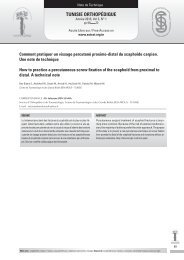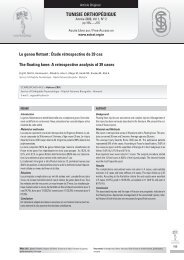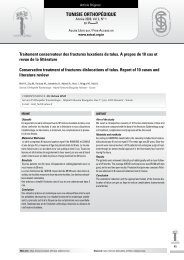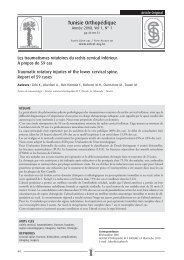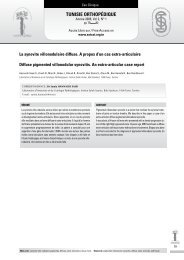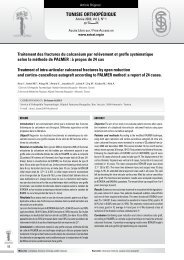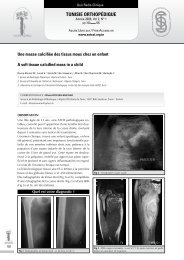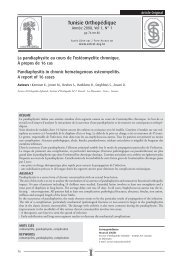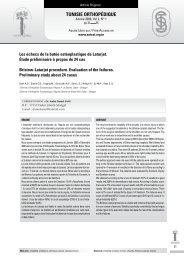Robert», la partie de l'art médical qui a pour objet - sotcot
Robert», la partie de l'art médical qui a pour objet - sotcot
Robert», la partie de l'art médical qui a pour objet - sotcot
You also want an ePaper? Increase the reach of your titles
YUMPU automatically turns print PDFs into web optimized ePapers that Google loves.
Article OriginalTunisie OrThOpédiqueAnnée 2008, Vol 1, N° 2pp 178 182Accés Libre sur / Free Access onwww.<strong>sotcot</strong>.org.tnsouffrance du nerf ulnaire au cou<strong>de</strong> et paraostéoarthropathie neurogènecompressive ulnar nerve syndrome and heterotopic ossificationAloui I., Hamdi M.F., Jawahdou R., Al<strong>la</strong>gui M., Zrig M., Mnif H., Koubaa M., Abid A.Service d’Orthopédie Traumatologie. Hôpital Fattouma Bourguiba. Monastir - TunisieCORRESPONDANCE: issam alouiService d’Orthopédie Traumatologie. Hôpital Fattouma Bourguiba. Monastir - TunisieE-mail : aloui_issam2001@yahoo.frrésuméObjectifsLa paraostéoarthropathie neurogène (POAN) est une pathologie fréquentechez les patients cérébrolésés. Elle peut se compliquer <strong>de</strong> compression nerveuseen particulier du nerf ulnaire. L’objectif <strong>de</strong> notre travail est <strong>de</strong> discuter<strong>la</strong> physiopathogénie <strong>de</strong> <strong>la</strong> souffrance nerveuse, détailler <strong>la</strong> technique chirurgicale<strong>de</strong> <strong>la</strong> neurolyse et d’établir une stratégie <strong>de</strong> prise en charge <strong>de</strong> cettecomplication en fonction du <strong>de</strong>gré <strong>de</strong> maturité <strong>de</strong> l’ostéome.Matériel et métho<strong>de</strong>sIl s’agit d’une étu<strong>de</strong> rétrospective portant sur 5 cas <strong>de</strong> souffrance du nerfulnaire au cou<strong>de</strong> suite à une POAN, opérés entre 2000 et 2005. Tous nos ma<strong>la</strong><strong>de</strong>sétaient <strong>de</strong> sexe masculin avec un age moyen <strong>de</strong> 33 ans. La souffrancenerveuse était sévère dans <strong>de</strong>ux cas et modérée dans trois cas. Tous lescou<strong>de</strong>s étaient ankylosés entre 60° et 120° <strong>de</strong> flessum. Un seul ma<strong>la</strong><strong>de</strong> a euun geste <strong>de</strong> neurolyse avant <strong>la</strong> maturité <strong>de</strong> l’ostéome.Nous avons utilisé <strong>la</strong> c<strong>la</strong>ssification <strong>de</strong> Dellon <strong>pour</strong> évaluer <strong>la</strong> souffrance nerveusepré-opératoire et en post-opératoire nos résultats ont été évalués ense basant sur le score <strong>de</strong> Kleinmann et Bishop modifié.RésultatsAu terme d’un recul moyen <strong>de</strong> 4 ans, les résultats <strong>de</strong> <strong>la</strong> neurolyse étaientexcellent une fois, bons trois fois et mauvais une fois.DiscussionLa POAN ne semble pas être <strong>la</strong> cause directe <strong>de</strong> <strong>la</strong> compression du nerfulnaire mais elle aggrave <strong>la</strong> souffrance nerveuse par le biais du flessumqu’elle occasionne. La neurolyse du nerf ulnaire se fait en même temps que<strong>la</strong> résection <strong>de</strong> l’ostéome dans le cas ou celui-ci est mature. En revanche uneneurolyse, associée à une transposition antérieure du nerf, est recommandéedans un premier temps puis secondairement une résection <strong>de</strong> l’ostéomeune fois mature.ABsTrAcTIntroduction and purposeThe elbow is the joint most frequently affected by heterotopic ossification(HO) in head- injured patients. Loss of range of motion is the most commoncomplication and neurologic compression, especially of the ulnar nerve, hasbeen rarely reported. The purpose of this work is to discuss the pathophysiologyof the nerve entrapment and to establish a strategy for taking over thiscomplication consi<strong>de</strong>ring the maturity of HO.Materials and methodsWe analyzed retrospectively five cases of compressive ulnar nerve due toheterotopic ossification of the elbow managed from 2000 to 2005. All our patientsare male and the average age was 33 years. HO appeared after longtermcoma due to head injury in 4 cases and severely burn in one case. Thenerve entrapment was severe in two cases and mo<strong>de</strong>rate in three cases.The elbow was painless and fixed in all patients. Early <strong>de</strong>compression wasdone in only one of our cases; neurolysis and release were postponed untilmaturation of the ossification in the others. Pre-operatively, the condition ofthe ulnar nerve was gra<strong>de</strong>d according to severity, based on Dellon’s c<strong>la</strong>ssificationand post-operative outcome assessment was based on the modifiedKleiman and Bishop scoring system.ResultsAt four years follow-up, the neurolysis result was consi<strong>de</strong>red excellent in onecase, good in three cases and bad in one.DiscussionHO of the elbow does not appear to be the direct cause of the nerve compression;it certainly promotes tension and compression it because of flexionit causes. When HO is mature neurolysis can be combined with the elbowrelease. However, if neurologic symptoms are present, early neurolysis associedto anterior transposition should not be <strong>de</strong><strong>la</strong>yed.178mots clés : paraosteoarthropathie neurogène, cou<strong>de</strong>, souffrance nerveuse, nerf ulnaire Keywords : heterotopic ossification, elbow, compressive syndrome, ulnar nerve



